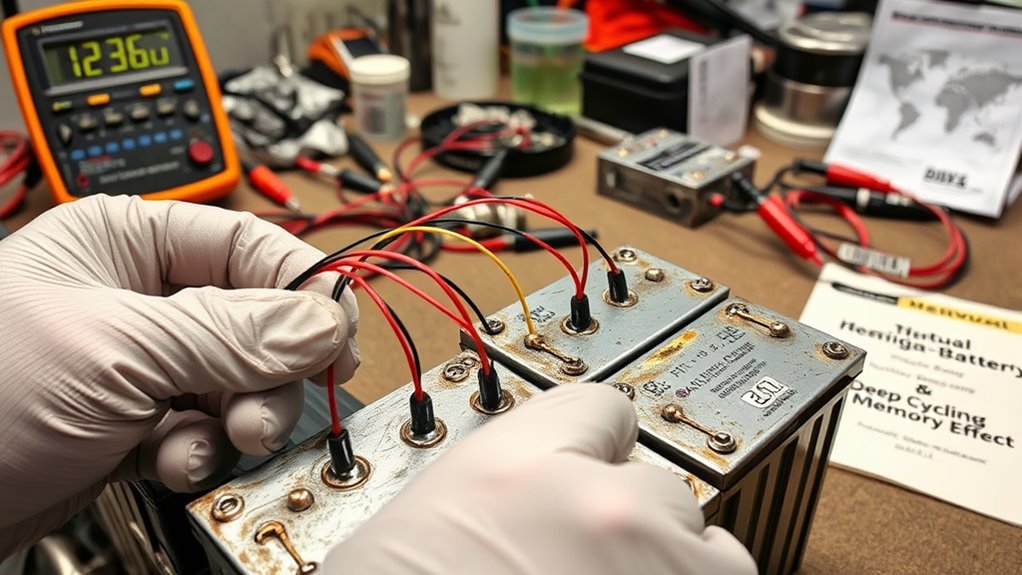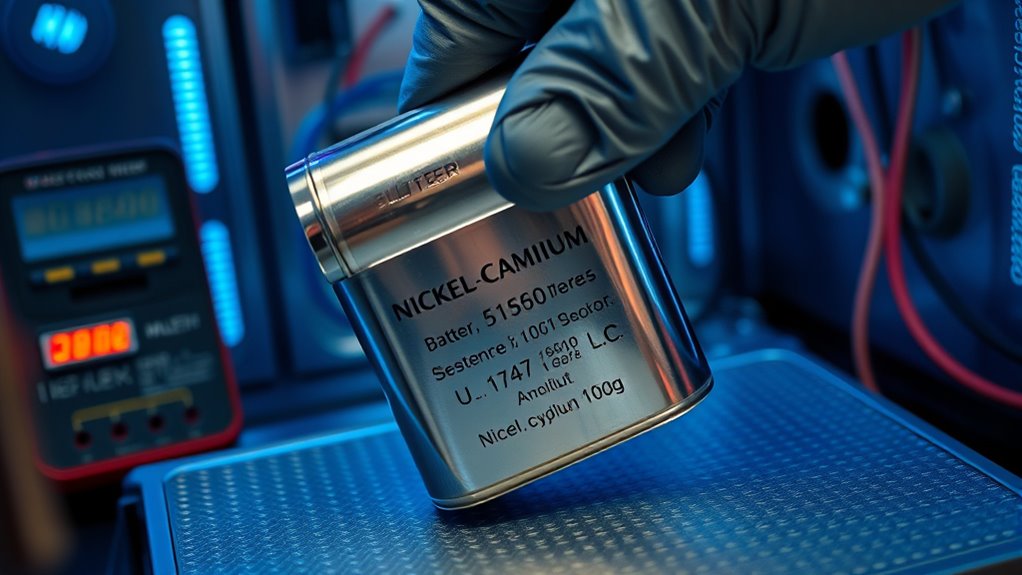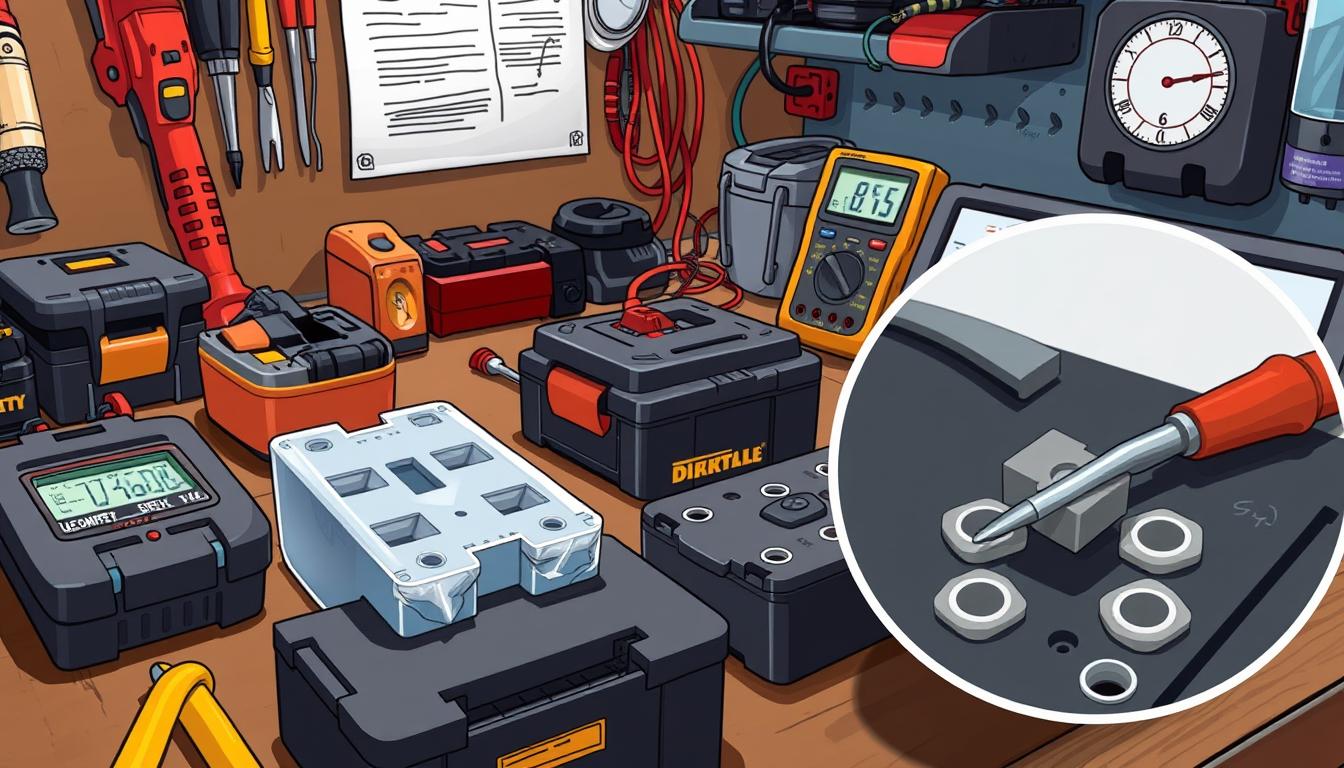To recondition nickel-cadmium batteries and tackle the memory effect, you should perform deep cycling—fully discharging the battery followed by a complete recharge. This process resets the battery’s memory and restores its capacity, improving performance and extending lifespan. Repeating deep cycling helps guarantee the battery operates efficiently again. If you’re interested in mastering this technique, there’s more valuable information ahead to help you achieve ideal results.
Key Takeaways
- Deep cycling involves fully discharging and recharging NiCd batteries to reverse the memory effect.
- Repeated deep cycling helps restore lost capacity caused by partial discharges.
- The memory effect leads to reduced runtime, which deep cycling can effectively counteract.
- Proper safety precautions are essential during deep cycling to prevent leaks, fires, or chemical exposure.
- Regular deep cycling extends battery lifespan and maintains optimal performance of NiCd batteries.

Reconditioning nickel-cadmium (NiCd) batteries can help restore their performance and extend their lifespan, saving you money and reducing waste. When working with these batteries, it’s vital to prioritize electrical safety. NiCd batteries contain toxic materials, and mishandling them can lead to leaks, fires, or chemical exposure. Always use protective gloves and eyewear, work in a well-ventilated area, and follow proper disposal procedures. By handling batteries carefully, you minimize risks and avoid accidents that could harm you or damage property. Additionally, maintaining safety standards during reconditioning helps prevent potential environmental hazards associated with improper disposal or accidental leaks. Proper reconditioning not only improves battery capacity but also contributes to environmental sustainability.
Understanding the memory effect is indispensable when reconditioning NiCd batteries. Over time, these batteries tend to “remember” the points of partial discharge, leading to reduced capacity and shorter runtime. This memory effect causes the battery to hold less charge because it “remembers” the smaller capacity from repeated partial cycles. To counteract this, deep cycling—completely discharging and then fully recharging the battery—is necessary. Deep cycling resets the battery’s memory, allowing it to regain lost capacity. You can do this by carefully discharging the battery using a suitable device until it’s nearly empty, then charging it fully without interruption. This process should be repeated a few times to effectively eliminate the memory effect and restore peak performance.
The process of deep cycling also positively impacts the environmental footprint of NiCd batteries. When batteries are reconditioned rather than replaced, fewer batteries end up in landfills, reducing toxic waste and contamination. Proper reconditioning prolongs the usability of existing batteries, cutting down on resource extraction, manufacturing energy, and disposal costs. It’s an eco-friendly practice that supports sustainability, especially when combined with responsible disposal after the battery reaches the end of its reconditioned lifespan.
Frequently Asked Questions
How Long Does a Typical Reconditioning Process Take?
A typical reconditioning process takes about 4 to 8 charging cycles, depending on the battery’s condition. You’ll need to fully charge and discharge the battery repeatedly, which can take several hours. This process helps restore the battery’s capacity and extend its lifespan. Be patient, as consistent deep cycling is key to effective reconditioning and maintaining ideal performance over time.
Can Reconditioning Restore 100% Original Capacity?
Reconditioning can markedly improve your battery’s capacity, but it might not restore it to 100% of its original capacity. While deep cycling helps optimize battery longevity and enhances capacity restoration, factors like age and usage impact the final results. You’ll likely see better performance and longer runtime, but some capacity loss may remain. Regular reconditioning extends your battery’s life, though it might not fully restore it to factory-new levels.
Are There Safety Risks Involved With Deep Cycling?
Deep cycling can pose safety risks, much like opening a sealed, aged container. You might encounter battery leakage or thermal hazards if the battery’s internal pressure builds up. Always wear protective gear, work in a well-ventilated area, and monitor the temperature. Overdoing it increases the risk of damaging the battery or causing leaks, so proceed cautiously and follow proper procedures to avoid accidents.
How Often Should I Recondition My Ni-Cd Batteries?
You should recondition your Ni-Cd batteries every few months or when you notice a decline in performance. Regular deep cycling helps extend their battery lifespan and maintains ideal charging frequency. Avoid over-reconditioning, as it can cause wear. Keep an eye on battery behavior, and recondition as needed to guarantee consistent power output and prolong their useful life. This proactive approach saves you money and keeps your devices running smoothly.
Is Reconditioning Cost-Effective Compared to Replacing Batteries?
You’ll find reconditioning your Ni-Cd batteries often more cost-effective than replacing them, especially when you consider long-term cost savings. Not only does this extend battery life, but it also reduces environmental impact by decreasing waste. Coincidentally, the effort you put into reconditioning can pay off by saving money and helping the environment. So, reconditioning is a smart choice that benefits your wallet and the planet.
Conclusion
Reconditioning nickel-cadmium batteries might seem simple, but it’s a delicate balance between deep cycling and avoiding the memory effect. While deep cycling revitalizes your battery’s capacity, neglect can lead to reduced lifespan. Think of it like watering a plant—you want enough to refresh, but not drown. By understanding these techniques, you preserve power and extend your battery’s life, turning a tired cell into a reliable source of energy—proof that careful care makes all the difference.









